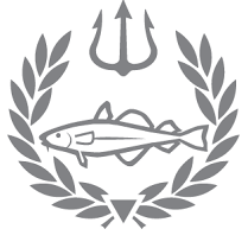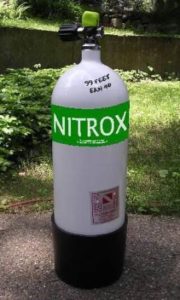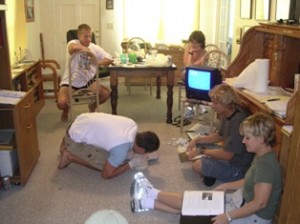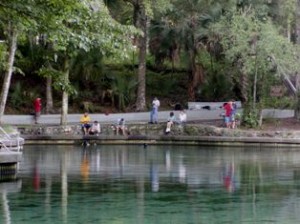 This is the first free time that I’ve had in two days to write (or sleep!) so right now I’m in the airport terminal catching up on entries. The past two days have been filled with amazing wreck diving and lots of video editing. My only previous experience with this kind of stuff was with iMovie for a presentation junior year. iMovie is a lot simpler than the Stayer’s professional production equipment! They have Media100 which is used in conjunction with Photoshop7 and Adobe After Effects. I started using the camera gear and editing software the first full day I was here so luckily I got the hang of it before leaving.
This is the first free time that I’ve had in two days to write (or sleep!) so right now I’m in the airport terminal catching up on entries. The past two days have been filled with amazing wreck diving and lots of video editing. My only previous experience with this kind of stuff was with iMovie for a presentation junior year. iMovie is a lot simpler than the Stayer’s professional production equipment! They have Media100 which is used in conjunction with Photoshop7 and Adobe After Effects. I started using the camera gear and editing software the first full day I was here so luckily I got the hang of it before leaving.
Last entry I thought I had spent all day editing….nope, not even close! Wednesday I was up until 3:45 am and then on Thursday was up until 6:15 am finishing it up. Pat almost pulled an all-nighter with me, she was up to 4 am this morning! We were worried that we wouldn’t finish in time, but thankfully Jim got it onto VHS before my trip home; it is roughly 13 minutes and has a lot of footage from the wrecks!!
THE DIVES: We have been in major crunch-mode but the four two five hours we spent diving on both Wednesday and on Thursday were incredible. The water was about 66 degrees on the surface and we all used drysuits again because it gets a lot colder at the bottom. Wednesday we went out with Bill, another charter captain and friend of the Stayers, to dive the Mary Alice B. and the front half of the Regina.
The Mary Alice B. is a 65 foot steel tug-boat sitting perfectly upright in about 92 feet of water. She took on more water than the pumps could handle while being towed from Rockport to Detroit in 1975; the Stayers discovered her in 1992. Diving on this wreck was an amazing experience, I felt like I had gone back in time. Although many of Mary Alice’s surfaces were covered in zebra mussels (a non-native species that invaded the great lakes but, because they filter water, also made the water more clear), she looks perfectly preserved. Not only are the wood and ropes intact from sinking, the wheelhouse is picturesque and complete with the wooden wheel. It’s breathtaking. We swam around the tug and peered in the head, the galley (which had the remains of some plates), and the engine room. I wish I could have stayed down there forever! Our second dive that day was awesome as well.
The Regina is a 250 foot steel freighter lying upside down in 77 feet of water that is thought to have sunk in the “big storm of 1913” on Lake Huron, in which many large ships were consumed by the sea. She was found by a local man in 1986, her hull completely ripped open midship. As we descended onto the Regina, a massive looming shadow came into view. Getting closer I almost choked on my regulator when I saw the size of the prop. Jim had told me earlier to swim behind it for the camera once we got down there because it was “big” but I did not imagine it to be THAT enormous!! I felt a little spooked getting so close to it, the whole wreck had a very eerie feel. I followed Jim around the bottom of the wreck, he showed me the smokestack and one of the masts, and we peered underneath her hull to see the cargo area inside. The sand is littered with countless artifacts, from whistles, to bells, and anchors to glassware and the dozens of portholes just LAYING in the sand. It was shocking. I think I know a few people who wouldn’t be allowed near this wreck! Needless to say, Wednesday was a spectacular day of diving.
Thursday was just as interesting because we got to see the other half of the Regina, the bow. We logged a bottom time of 29 minutes and I reached 78 feet where the cargo dug into the sand. The bow is covered in a row of intact portholes and the bottom, similar to the stern, is filled with artifacts. I shined my light under the hull and saw gigantic pieces of wooden decking and a few ladders. Since the wreck is upside down, Jim took me up to the keel to see the huge rip that caused the freighter. The sheer size of it was intimidating. It had to have taken something really powerful to rip through that hunk of steel. That was our only dive on Thursday, but still a stunning one to end on. Jim let me use his video camera on each of the wrecks so I was able to get footage of them all, documenting my first time freshwater wreck diving.
My trip with the Stayers continued to open my eyes to new worlds of diving, and also of video production! The amount of effort Jim and Pat put into producing their videos or other people’s videos is impressive, and a full-time job in itself. A lot of time is put into making a little segment of video. I got the chance to learn about what goes on “behind-the-scenes” when making an underwater movie, during my stay with Jim and Pat. Not only does one have to be artistic and have a creative eye, he or she must have the skills on multiple levels, from camera control in currents and waves to color-correction and other editing abilities, in order to produce a pleasing finished product.
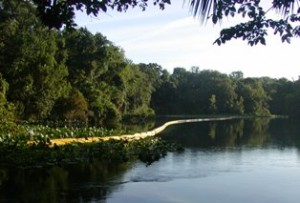 While Tim, Lee, Paul, and James were out in the field collecting water samples for the Cambrian Foundation’s Central Florida Springs Project, Josh and I spent the day with Amy and her college professor, Dr. McShafferty, catching Dragonflies and Damselflies. Dr. McShafferty loves bugs. He wants to collect specimens from the Orlando area before returning up north, so Amy brought us to the Wekiva River and then through the Wekiwa Springs State Park today.
While Tim, Lee, Paul, and James were out in the field collecting water samples for the Cambrian Foundation’s Central Florida Springs Project, Josh and I spent the day with Amy and her college professor, Dr. McShafferty, catching Dragonflies and Damselflies. Dr. McShafferty loves bugs. He wants to collect specimens from the Orlando area before returning up north, so Amy brought us to the Wekiva River and then through the Wekiwa Springs State Park today.